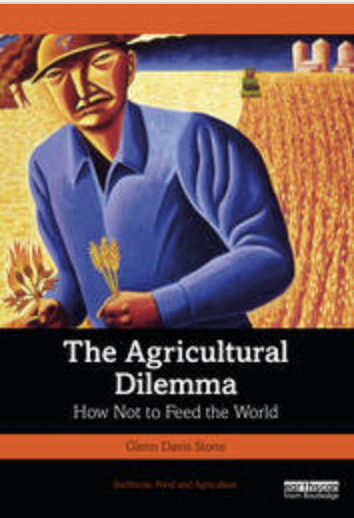Stone, Glenn, Davis. The Agricultural Dilemma. 1st edition. New York, NY: Routledge, 2022.
Since the mid-19th century (Stone pegs the key year as 1840), a nexus of self-serving scientists, government, and industry have embraced a neo-Malthusian mantra that the only way to prevent starvation in the face of a rising global population is by industrializing agriculture to increase the food supply. In The Agricultural Dilemma: How Not to Feed the World, Glenn Davis Stone thoroughly and amply demonstrates that they are wrong. The tension between social scientists and neo-Malthusians is an old one: geographer Carl Sauer warned the Rockefeller Foundation against its Mexican Agricultural Program (MAP) in the early 1940s (Jennings 1988) and the International Rice Research Institute (IRRI) marginalized social science during the Green Revolution of the 1960s (Oasa 1981). However, as Stone notes, until now publications scientifically demonstrating the fallacies of neo-Malthusianism have been academic, limiting their audience – and the impact of their message. Stone’s new accessibly (and occasionally irreverently) written book aims to correct that; although academically rigorous, its message is concise and streamlined and it can be easily understood by non-academics.
Stone presents his argument by describing three types of agriculture: Malthusian, industrialized, and intensive. Malthusian agriculture conforms to Malthus’ (incorrect) assumption that the only way to increase the food supply is by bringing more land under the plow. Industrialized agriculture, the focus of most of the book, is “the result of [subsidized] industry appropriating processes within farm production and selling them back as inputs” to overproduce food (p. 14). This is the core of Stone’s argument, and most of the book is devoted to amply supporting it with evidence. He shows that, even as neo-Malthusians called for industrializing agriculture as the only way to stem hunger, they were struggling with problematic surpluses due to industrialized agriculture. Stone refers to advocates of industrialized agriculture as neo-Malthusians because they recognize that increased yields are possible but retain Malthus’ belief that the population will grow unchecked and inevitably outstrip the food supply. The third type of agriculture – intensive – relies on skilled labor, knowledge, and innovation to increase agricultural productivity when needed – and only when needed – due to population pressure with limited reliance on external inputs and markets. “Malthus had gotten it not just wrong, but backward,” writes Stone, citing the work of agricultural economist Ester Boserup (p. 204). In intensive farming systems, population pressure drives agriculture, not the other way around.
After laying out his theoretical framework in the first chapter, Stone situates Malthus’ theory about population and food supply in Malthus social location as a cleric born into the British gentry in the late 17th century (chapter two). Ignorant of agriculture, Malthus formed his conclusions after observing the poor among his parishioners in an area of concentrated poverty due to British social policies of the time. The next four chapters form the heart of the book, laying out Stone’s theory of industrial agriculture in (chapter 3), and supporting it with data from three cases: fertilizer (chapter 4), hybrid corn (chapter 5), and the Green Revolution (chapter 6). Stone ends with a chapter on intensive agriculture, showing there is an alternative option to industrial agriculture that already provides an estimated 50% to 75% of the world’s food (p. 211).
In many ways, the book’s content stems from its purpose as a theoretical refutation of neo-Malthusianism claims. As Stone notes more than once, any criticism of industrial agriculture is met by accusations of Romanticism and condemning millions to starvation. Here, Stone hits back directly, attacking his opponents on their weakest point: while neo-Malthusians claim to work in the interests of farmers and the hungry, Stone shows they are in fact acting to benefit themselves while harming farmers (especially poor farmers), without addressing hunger. The book is tightly focused around this point. Romanticism has played a role in consumer food movements skeptical of industrialization in the U.S. (DuPuis 2015), but Stone’s critique of industrial agriculture comes entirely from natural and social scientific research. Stone is thorough in demonstrating that the very justification for industrialized agriculture – its necessity to “feed the world” – is false. In fact, Stone shows that industrializing agriculture did not increase yields beyond the pre-industrial growth it was already experiencing; some increases in productions of specific crops (like wheat) are due to farmers responding to government policies incentivizing growing wheat and taking land out of other crops; modern famines are due to social factors rather than failure to grow sufficient food; industrial agriculture forces farmers onto a technological treadmill that disproportionately benefits the wealthiest farmers while causing widespread deskilling; and the same governments that promote industrialized agriculture struggle to store or utilize the oversupply of food it produces.
Although he did not neglect to examine systems of oppression like racism and classism, Stone could have gone further in analyzing their role. He reliably notes when neo-Malthusians express overt racism, eugenics, and anti-Semitism, but he does not systematically examine the role of racism in population anxieties as other scholars have done (Park and Pellow 2011; Wilde 2019), nor does he examine the role of racism when it is not expressed overtly. Given the number of quotes he shares by white, middle- and upper-class Americans who describe farmers – especially farmers in the Global South who Stone demonstrates are skilled, knowledgeable, and innovative – as backward, stagnant, ignorant, and in need of instruction from themselves, it would be illuminating to read an analysis of the more covert role of classism and racism in the campaign to industrialize agriculture.
Altogether, The Agricultural Dilemma is an excellent addition to the literature that synthesizes a staggering amount of research by scholars like Robert Netting, James Scott, Jack Kloppenburg, Jan Douwe van der Ploeg, Nick Cullather, and Stone himself. The book can bring social science to both academic and non-academic audiences alike in an important public debate that has marginalized social science since at least the 1940s.
Jill Richardson is a PhD candidate in sociology at University of Wisconsin-Madison. She is an environmental sociologist who engages a broad range of theoretical perspectives that emphasize approaches to building relationships of mutual respect, sharing knowledge, and building trust to manage natural resources equitably and sustainably. She expects to graduate in May 2023.
References:
DuPuis, E. Melanie. Dangerous Digestion: The Politics of American Dietary Advice, 2015.
Jennings, Bruce H. Foundations of International Agricultural Research: Science and Politics in Mexican Agriculture. Westview Press, 1988.
Oasa, Edmund K. “The International Rice Research Institute and the Green Revolution : A Case Study on the Politics of Agricultural Research,” 1981. http://hdl.handle.net/10125/10099.
Park, Lisa Sun-Hee, and David Pellow. The Slums of Aspen: Immigrants vs. the Environment in America’s Eden. New York: NYU Press, 2011.
Wilde. Birth Control Battles. First edition. Oakland, California: University of California Press, 2019.
© 2022 Jill Richardson
Jill Richardson is a PhD candidate in sociology at University of Wisconsin-Madison. She is an environmental sociologist who engages a broad range of theoretical perspectives that emphasize approaches to building relationships of mutual respect, sharing knowledge, and building trust to manage natural resources equitably and sustainably. She expects to graduate in May 2023.


